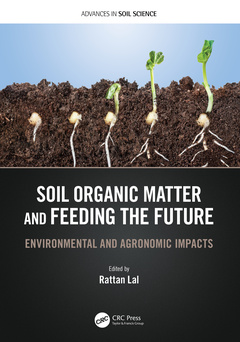Soil Organic Matter and Feeding the Future Environmental and Agronomic Impacts Advances in Soil Science Series
Coordonnateur : Lal Rattan

Soil organic matter (SOM) is the primary determinant of soil functionality. Soil organic carbon (SOC) accounts for 50% of the SOM content, accompanied by nitrogen, phosphorus, and a range of macro and micro elements. As a dynamic component, SOM is a source of numerous ecosystem services critical to human well-being and nature conservancy. Important among these goods and services generated by SOM include moderation of climate as a source or sink of atmospheric CO2 and other greenhouse gases, storage and purification of water, a source of energy and habitat for biota (macro, meso, and micro-organisms), a medium for plant growth, cycling of elements (N, P, S, etc.), and generation of net primary productivity (NPP). The quality and quantity of NPP has direct impacts on the food and nutritional security of the growing and increasingly affluent human population.
Soils of agroecosystems are depleted of their SOC reserves in comparison with those of natural ecosystems. The magnitude of depletion depends on land use and the type and severity of degradation. Soils prone to accelerated erosion can be strongly depleted of their SOC reserves, especially those in the surface layer. Therefore, conservation through restorative land use and adoption of recommended management practices to create a positive soil-ecosystem carbon budget can increase carbon stock and soil health.
This volume of Advances in Soil Sciences aims to accomplish the following:
- Present impacts of land use and soil management on SOC dynamics
- Discuss effects of SOC levels on agronomic productivity and use efficiency of inputs
- Detail potential of soil management on the rate and cumulative amount of carbon sequestration in relation to land use and soil/crop management
- Deliberate the cause-effect relationship between SOC content and provisioning of some ecosystem services
- Relate soil organic carbon stock to soil properties and processes
- Establish the relationship between soil organic carbon stock with land and climate
- Identify controls of making soil organic carbon stock as a source or sink of CO2
- Connect soil organic carbon and carbon sequestration for climate mitigation and adaptation
1. Enhancing Fertilizer Use Efficiency by Managing Soil Health: Emerging Trends 2. Conservation Agriculture: Carbon and Conservation Centered Foundation for Sustainable Production 3. Relating Soil Organic Carbon Fractions to Crop Yield and Quality with Cover Crops 4. Global Spread of Conservation Agriculture for Enhancing Soil Organic Matter, Soil Health, Productivity and Ecosystem Services 5. The effects of soil organic matter and organic resource management on maize productivity and fertilizer use efficiencies in Africa 6. Cover cropping for Managing Soil Organic Carbon Content 7. Fertilizer Use in the North China Plains for Improving Soil Organic Matter Content and Crop Yield 8. Managing Rainfed Rice Farms for Improving Soil Health and Advancing Food Security: A Meta-analysis 9. Soil organic matter: Bioavailability and bio-fortification of essential micronutrients 10. Raising Soil Organic Matter to Improve Productivity and Nutritional Quality of Food Crops in India 11. Role of Legumes in Managing Soil Organic Matter and Improving Crop Yield 12. Managing Soil Organic Carbon in Crop lands of the Eastern Himalayas, India 13. Soil Organic Carbon Restoration in India: Programs, Policies, and Thrust Areas 14. No-Tillage Farming in Maghreb Region: Enhancing agricultural productivity and sequestrating carbon in soils 15. No-till farming for managing soil organic matter in semi-arid, temperate regions: synergies, tradeoffs, and knowledge gaps
Rattan Lal, PhD, is Distinguished University Professor and Director of the Carbon Management and Sequestration Center at The Ohio State University, and Adjunct Professor at the University of Iceland and IARI, New Delhi. He was President of the WASWAC (1987-1990), ISTRO (1988-1991), SSSA (2006-2008), and the IUSS (2017-2018). He researches soil C sequestration, conservation agriculture, soil health, soil erosion and C dynamics, soil structure, eco-intensification, soil restoration, and soils of the tropics. He has authored 1,020 journal articles, authored/edited more than 100 books, mentored 370 researchers, has h-index of 163, and total citations of 120,719. In a Stanford study (Ioannidis et al. 2019, 2020), he is ranked #111 globally among world’s top 2% of scientists, and #1 among scientists in Agronomy & Agriculture. Reuter Thompson ranked him #391 among the top 1000 climatologists. He holds IICA’s Chair in Soil Science and Goodwill Ambassador in Sustainable Development. He is a member of the 2021 U.N. Food System Summit Science Committee and Action Track 3. He received the 2018 GCHERA World Agriculture Prize, 2018 Glinka World Soil Prize, 2019 Japan Prize, 2019 IFFCO Award, 2020 Arrell Global Food Innovation Award, the 2020 World Food Prize, and the 2021 Padma Shri Award, India.
Date de parution : 12-2021
17.8x25.4 cm
Thèmes de Soil Organic Matter and Feeding the Future :
Mots-clés :
SOC Stock; Soil Fertility; SOC; Som Content; High SOC Stock; CCs; SOC Concentration; Soil Quality; CA System; NT System; Cover Crop Species; Hairy Vetch; Cover Crop Biomass; ISFM; Cover Crop Residues; SOC Sequestration Rate; Crimson Clover; SOC Status; Stable SOC; Conservation Tillage; Crop Residues; Crop Yield; NEH Region; Legume Cover Crops; Fluvo Aquic Soil



